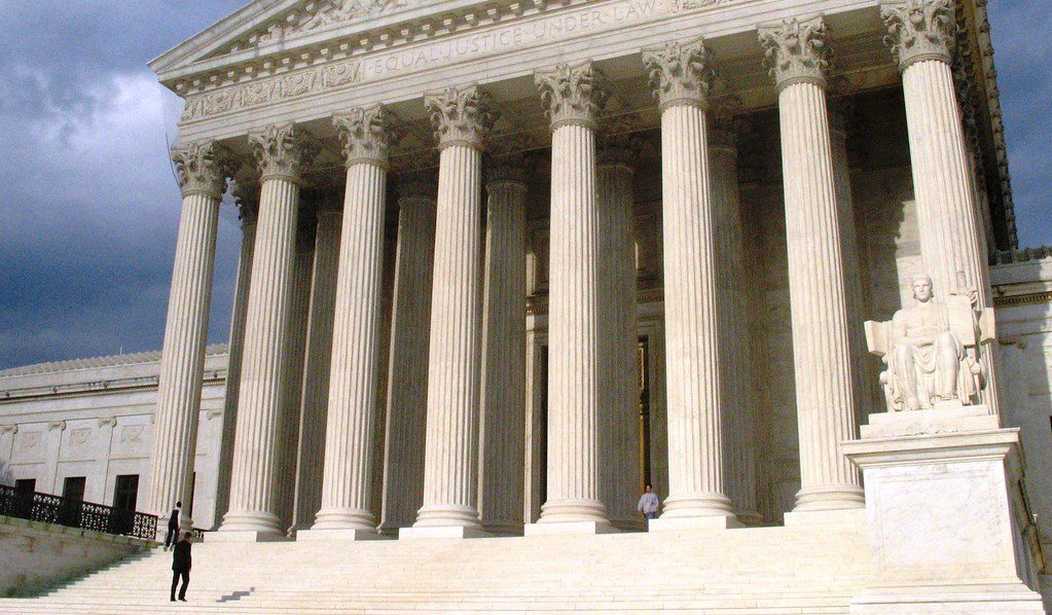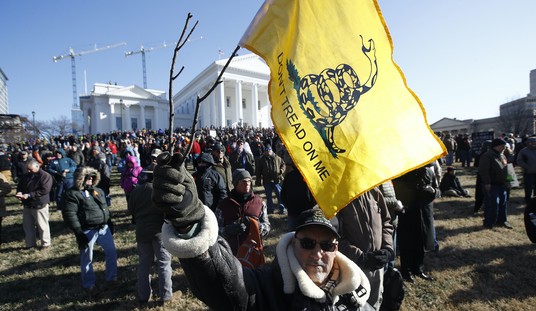In addition to the majority and dissenting opinions in the Rahimi case, there were five separate concurring opinions released today. The liberal wing of the Supreme Court provided two of those opinions, one from Justice Sonia Sotomayor joined by Justice Elana Kagan and another from Justice Ketanji Brown Jackson. Justices Neil Gorsuch, Brett Kavanaugh, and Amy Coney Barrett meanwhile, all weighed in with thoughts of their own that were largely centered around the "text, history, and tradition" test laid out by the Court in Bruen.
There's been a lot of speculation that Barrett was getting ready to break with the originalists on the Court over the use of history and tradition to determine the constitutionality of laws, but the justice instead tried to stake out a muddy middle ground. History should be taken into account, but it shouldn't be looked at too narrowly.
Courts have struggled with this use of history in the wake of Bruen. One difficulty is a level of generality problem:Must the government produce a founding-era relative of thechallenged regulation—if not a twin, a cousin? Or do founding-era gun regulations yield concrete principles that mark the borders of the right? Many courts, including the Fifth Circuit, have understood Bruen to require the former, narrower approach. But Bruen emphasized that “analogical reasoning” is not a “regulatory straightjacket.” To be consistent with historical limits, a challenged regulation need not be an updated model of a historical counterpart. Besides, imposing a test that demands overly specific analogues has serious problems. To name two: It forces 21st-century regulations to follow late-18th-century policy choices, giving us “a law trapped in amber.” And it assumes that founding-era legislatures maximally exercised their power to regulate, thereby adopting a “use it or lose it” view of legislative authority. Such assumptions are flawed, and originalism does not require them.
As much as any 2A opinion that makes @JacobDCharles happy annoys me 🤣, Barrett is correct that originalism is not, and never was a "use it or lose it" pact. Particularly with new problems not present then, which is when Bruen's "more nuanced approach" applies.
— Kostas Moros (@MorosKostas) June 21, 2024
However, I think… pic.twitter.com/9xGkXhjl4u
Barrett presumably prefers the approach adopted by the majority, which she calls "original contours" history.
Original history”—i.e., the generally dispositive kind— plays two roles in the Second Amendment context. It elucidates how contemporaries understood the text—for example, the meaning of the phrase “bear Arms.” See Heller, 554 U. S., at 582–592. It also plays the more complicated role of determining the scope of the pre-existing right that the people enshrined in our fundamental law.* In Rahimi’s case, the Court uses history in this latter way. Call this “original contours” history: It looks at historical gun regulations to identify the contours of the right.
History is still supposedly an important consideration for Barrett, although she noted in her footnote in the passage above that the "original contours" history "walks a fine line between original meaning (which controls) and expectations about how the text would apply (which do not)."
Contemporary government actors might have been “wrong about the consequences of their own constitutional rule,” or they “might not have fully and faithfully implemented the adopted constitutional rule themselves.” Thus, while early applications of a constitutional rule can help illuminate its original scope, an interpreter must exercise care in considering them. In the Second Amendment context, particular gun regulations—even if from the ratification era—do not themselves have the status of constitutional law.
In other words, the mere existence of an 18th or 19th century statute doesn't mean that it was constitutional, either then or now. Barrett contends that “analogical reasoning” under Bruen "demands a wider lens: Historical regulations reveal a principle, not a mold."
That doesn't necessarily mean that Barrett is going soft on the Second Amendment. As she pointed out, the Court has already essentially adopted that standard by unequivocally stating that the right to keep and bear arms doesn't just apply to those arms that were in existence in 1791. Barrett also cautioned that courts "must be careful not to read a principle at such a high level of generality that it waters down the right," which, unfortunately, lower courts have been doing ever since Heller was decided.
Barrett believes that the principle can be applied too narrowly or too broadly, but just like the last bowl of porridge Goldilocks discovered, "the Court settles on just the right level of generality:
Since the founding, our Nation’s firearm laws have included provisions preventing individuals who threaten physical harm to others from misusing firearms. Section 922(g)(8)(C)(i) fits well within that principle; therefore, Rahimi’s facial challenge fails. Harder level-of-generality problems can await another day.
While Justice Gorsuch agreed with the bottom line in Rahimi, and even went so far as to agree with Barrett that the government didn't need to show that "the current law is a 'dead ringer' for some historical analogue", he also maintains that in order for a gun control law that implicates the Second Amendment to be upheld, the government "must establish that, in at least some of its applications, the challenged law 'impose[s] a comparable burden on the right of armed self-defense' to that imposed by a historically recognized regulation. And it must show that the burden imposed by the current law 'is comparably justified.'"
Why do we require those showings? Through them, we seek to honor the fact that the Second Amendment “codified a pre-existing right” belonging to the American people, one that carries the same “scope” today that it was “understood to have when the people adopted” it. When the people ratified the Second Amendment, they surely understood an arms-bearing citizenry posed some risks. But just as surely they believed that the right protected by the Second Amendment was itself vital to the preservation of life and liberty.
Gorsuch also rejected the idea that "history, text, and tradition" isn't the proper test to determine whether a gun law passes constitutional muster, noting that the interest-balancing test adopted by some courts like the Ninth Circuit have led to what critics have called "window dressing for judicial policymaking."
Love this! Gorsuch calls out the Ninth Circuit, citing the bestest judge in the country. pic.twitter.com/rrUPiudDiE
— Kostas Moros (@MorosKostas) June 21, 2024
Brett Kavanaugh's lengthy concurrence focused almost exclusively on the "text, history, and tradition" test as well. While Kavanaugh, along with the rest of the justices, didn't want to delve into whether 1791 or 1868 (when the Fourteenth Amendment was ratified) is the time period that matters more in determining the tradition of the right to keep and bear arms, he made it clear that post-ratification history must carry some weight.
In relying on post-ratification history as a proper tool to discern constitutional meaning, Madison and Marshall make for a formidable duo. Moving from distant American history to more recent times, one can add Justice Scalia. Throughout his consequential 30-year tenure on this Court, Justice Scalia repeatedly emphasized that constitutional interpretation must take account of text, pre-ratification history, and post-ratification history—the last of which he often referred to as “tradition.” In his words, when judges interpret vague or broadly worded constitutional text, the “traditions of our people” are “paramount.”
So long as "tradition" isn't used as a substitution or analogue for "legislation" or "jurisprudence", I agree with Kavanaugh up to a point. There were a number of state and local gun laws enacted after the Civil War, for example, but many of them were either explicitly or implicitly meant to deprive freedmen from exercising their newfound Second Amendment rights. What should be seen as more in line with the tradition of the Second Amendment; armed citizen groups like the Union League that formed in the Deep South in the wake of the Civil War, or the Black Codes that were enacted with an eye towards disarming members of those groups in many southern states?
Kavanaugh does squarely reject the idea of going back to an interest-balancing test, declaring that "one major problem with using a balancing approach to determine exceptions to constitutional rights is that it requires highly subjective judicial evaluations of how important a law is—at least unless the balancing test itself incorporates history, in which case judges might as well just continue to rely on history directly."
As the Court’s decision today notes, Second Amendment jurisprudence is still in the relatively early innings, unlike the First, Fourth, and Sixth Amendments, for example. That is because the Court did not have occasion to recognize the Second Amendment’s individual right until recently. Deciding constitutional cases in a still-developing area of this Court’s jurisprudence can sometimes be difficult. But that is not a permission slip for a judge to let constitutional analysis morph into policy preferences under the guise of a balancing test that churns out the judge’s own policy beliefs.
So what does all this mean? Well, for starters, it's clear that a majority of the Court is unwilling to scrap the "text, history, and tradition" test, even if Barrett left the door open to refine that test going forward. That's good news, but as Justice Clarence Thomas pointedly noted in his dissent, by allowing historical statutes that are materially different in scope and intent to serve as analogues to Section 922(g)(8), the Court has given judges the green light to use highly questionable comparisons to uphold modern gun laws.
Does that mean that the Supreme Court will always go along with that? Absolutely not. But even going back to Bruen, the Court has made it pretty clear that a historical twin isn't necessary to find a 21st century gun law constitutional. The justices rejected New York's "may issue" carry laws, but found "shall issue" licensing laws presumptively constitutional even though concealed carry permits (or carry permits in general) weren't around in 1791 or 1868.
If the "text, history, and tradition" test is going to mean anything at all, then the Court needs to quit pussyfooting around the issue of what history is important and what constitutes a tradition of keeping and bearing arms. The 6-3 majority that complained in Bruen about lower courts intentionally ignoring its previous guidance failed to offer any more explicit direction in Rahimi, and instead has come up with an opinion that invites more abuses in the future.









